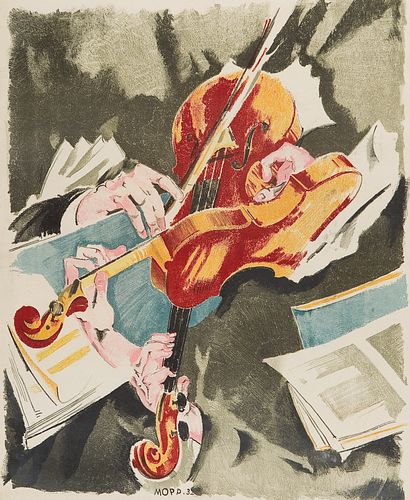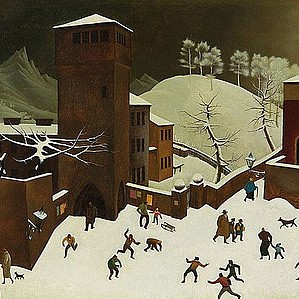MAX OPPENHEIMER (Vienna 1903 - 1954 New York) Amati, 1932
Lot 87
Categories
Estimate:
EUR€3,000 - EUR€5,000
$3,260.87 - $5,434.78
Absentee vs Live bid
Two ways to bid:
- Leave a max absentee bid and the platform will bid on your behalf up to your maximum bid during the live auction.
- Bid live during the auction and your bids will be submitted real-time to the auctioneer.
Bid Increments
| Price | Bid Increment |
|---|---|
| EUR€0 | EUR€10 |
| EUR€100 | EUR€50 |
| EUR€700 | EUR€100 |
| EUR€1,000 | EUR€200 |
| EUR€3,000 | EUR€300 |
| EUR€3,600 | EUR€400 |
| EUR€4,000 | EUR€500 |
| EUR€7,000 | EUR€1,000 |
| EUR€16,000 | EUR€2,000 |
| EUR€30,000 | EUR€3,000 |
| EUR€36,000 | EUR€4,000 |
| EUR€40,000 | EUR€5,000 |
About Auction
By Widder Auctions
May 19, 2022
Set Reminder
2022-05-19 11:00:00
2022-05-19 11:00:00
America/New_York
Bidsquare
Bidsquare : Masterpieces
https://www.bidsquare.com/auctions/widder-auctions/masterpieces-9287
Masterpieces of classical modernism by Austrian and international artists coming up for auction in Vienna on May 19th Widder Auctions office@widderauktionen.com
Masterpieces of classical modernism by Austrian and international artists coming up for auction in Vienna on May 19th Widder Auctions office@widderauktionen.com
- Lot Description
MAX OPPENHEIMER*
(Vienna 1903 - 1954 New York)
Amati, 1932
color lithography/paper, 67 x 55 cm
monogrammed and dated in stone MOPP 32
depicted in cat. raisonné Pabst, Munich 1993, No. L 22, and in the exhibition catalogue of the Jewish Museum in Vienna, 1994, p. 163
Provenance: private property Vienna
ESTIMATE °€ 3.000 - 5.000
Austrian artist of the 20th century. Important representative of the Austrian avant-garde. 1900 to 1903 studied at the Academy of Fine Arts in Vienna, 1903 to 1906 at the Prague Academy of Arts. 1906 Member of the Prague group OSMA (The Eight), including representatives of the Czech avant-garde such as Otakar Kubín, Emil Filla, Bohumil Kubišta and Emil Artur Longen, among others. In 1908 and 1909 participated in the Vienna Art Show. Early influences of Vincent van Gogh, counted among the Viennese Expressionists around Egon Schiele, Oskar Kokoschka and Albert Paris Gütersloh. 1911 to 1915 in Berlin, involvement with Cubism and collaboration on the journal Die Aktion. 1915 to 1925 in Switzerland, beginning his exploration of music. End of the 1920s in Berlin and from 1931 again in Vienna. 1932 emigration via Switzerland to the USA. In 1937 his works were classified by the Nazis as degenerate art. Created mainly portraits, religious depictions and scenes from everyday life. Numerous expressionist works with influences from Cubism and Futurism on the theme of music, impressive depictions of orchestras, composers and conductors. Focus on the visual representation of music interplay of musicians' hands, sheet music and instruments such as the famous violins from the Amati family of violin makers from Cremona.
The idea of making music the subject of fine arts results from the rise of music in the 19th century in the competition between artistic genres, the "paragone", which has been held since the Baroque era. The "ut pictura poesis" ("like painting, like poetry"), which goes back to Horace's "ars poetica", was replaced by the emphasis on the close connection between painting and music: "ut pictura musica". Max Oppenheimer, a gifted painter and graphic artist and one of the most important proponents of early expressionism in Austria along with Schiele and Kokoschka, was also a passionate musician. Not only did he have an extraordinary musical education, he also played the violin very well. He owned two valuable violins, a Vuillamue and one of the earliest Amatis from 1606. During his time in Switzerland from 1915 to 1925 he began to artistically deal with the subject of music, incorporating stylistic devices of Futurism and Cubism. Oppenheimer dealt with the Rosé Quartet several times and created the monumental oil painting "The Symphony" in 1923, which shows the Vienna Philharmonic under Gustav Mahler's baton and can be admired in the Belvedere. The Rosé Quartet, one of the most important ensembles of the early 20th century, was founded in Vienna in 1882 by the brothers Eduard and Arnold Rosé and gave its last concert in 1945 in exile in London. As a sensitive observer, Oppenheimer describes the devotion of the Rosé Quartet in the following words: "As soon as the first chords sounded, I found myself in front of other people. Their heads bowed and seemed to be listening inward.” Oppenheimer's works impress with their high quality of technical and artistic execution. Above all, he always succeeds in depicting movement in a two-dimensional still image and in translating the acoustic into the visual. 12 years later, the lithograph of “Amati” was created as a companion piece that was submitted later, whereby Oppenheimer had already realized the motif in 1918 as an oil painting and in 1924 as a lithograph for a Hagenbund poster. His favorite violin from the Cremonese workshop is presented to us twice, from different perspectives and again disregarding the conventional space-time structure. Both hands of the anonymous musician, probably identical to Oppenheimer's again, can also be seen twice each. Once the right bows the strings, once she plays pizzicato. The dynamics in "Rosé-Quartett" and in "Die Amati" are real and immediate: the hands making the music and the instruments are in motion just as violently as the sheet music.
PLEASE NOTE:
The purchase price consists of the highest bid plus the buyer's premium, sales tax and, if applicable, the fee of artists resale rights. In the case of normal taxation (marked ° in the catalog), a premium of 24% is added to the highest bid. The mandatory sales tax of 13% is added to the sum of the highest bid and the buyer's premium. The buyer's premium amounts to 28% in case of differential taxation. The sales tax is included in the differential taxation. - Shipping Info
-
Shipping
We will send you the invoice shortly after the auction. As soon as we have recieved the amount, the art can be picked up at Johannesgasse 9-13, 1010 Vienna. Please note that the buyer is responsible for pick-up and shipping of the lot.
Should you wish to ship your items, please contact: Mailboxes Email: oper@mbe-co.at Tel: 01 5128855
Please note that storage fees may apply, should the pieces not be picked up within 14 days after invoicing for domestic and 28 days for international transportation.
Our team will be happy to assist you with any further information at office@widderauktionen.com or at 0043 676 555 66 10.
-
- Buyer's Premium



 EUR
EUR CAD
CAD AUD
AUD GBP
GBP MXN
MXN HKD
HKD CNY
CNY MYR
MYR SEK
SEK SGD
SGD CHF
CHF THB
THB












